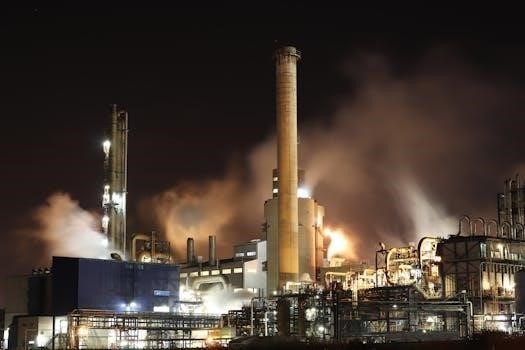Chemical Equilibrium⁚ Questions and Answers
Do you have questions about chemical equilibrium? Explore multiple-choice quizzes with detailed solutions, practice problems covering equilibrium constants, and real-world examples. Find answers regarding equilibrium expressions, calculations, and dynamic processes.
Understanding Chemical Equilibrium
Chemical equilibrium represents a state where the rates of forward and reverse reactions are equal, resulting in no net change in reactant and product concentrations. Grasping this dynamic process is crucial for predicting reaction outcomes. Many students often find the concepts surrounding equilibrium challenging, but with focused practice using PDFs of questions and answers, a deeper comprehension can be achieved. These resources often include worked examples and explanations, solidifying understanding of equilibrium constants, Le Chatelier’s principle, and reaction quotients. Practice questions with answers are invaluable tools for mastering these concepts. Use quizzes to assess understanding and identify areas needing further attention. By actively engaging with the material, one can develop a robust understanding of chemical equilibrium.
Key Concepts of Chemical Equilibrium
Essential concepts include the dynamic nature of equilibrium, equilibrium constants (K), and Le Chatelier’s Principle. These govern reaction direction and extent. Mastering these is key to solving equilibrium problems effectively.
Definition of Chemical Equilibrium
Chemical equilibrium is the state where the forward and reverse reaction rates are equal, leading to constant concentrations of reactants and products. It’s a dynamic process, not static, meaning reactions continue but without net change in concentrations. The equilibrium position indicates the relative amounts of reactants and products at equilibrium, influenced by factors like temperature and pressure. Understanding this definition is crucial for predicting reaction behavior and manipulating conditions to favor desired product formation. This concept is fundamental to solving various equilibrium problems, including calculations involving equilibrium constants and applying Le Chatelier’s principle. Grasping the dynamic nature and influencing factors is essential for advanced applications in chemistry.
Dynamic Nature of Equilibrium
The dynamic nature of equilibrium signifies that even when a reaction appears to have stopped, the forward and reverse reactions are still occurring. Reactants are continuously converting into products, and products are converting back into reactants at equal rates. This constant interplay maintains a stable concentration of all species involved. Imagine a saturated solution of NaCl in water; dissolution and precipitation of salt occur simultaneously, illustrating this dynamic process. Understanding this dynamic aspect is critical for comprehending how external factors influence equilibrium. Changes in concentration, pressure, or temperature can shift the equilibrium by affecting the rates of the forward or reverse reactions, leading to a new equilibrium state. It’s not a static endpoint but a continuous, balanced process.

Equilibrium Constant (K)
The equilibrium constant, denoted as K, quantifies the ratio of products to reactants at equilibrium. It provides insight into the extent to which a reaction proceeds to completion under given conditions.
Writing Equilibrium Expressions
Writing equilibrium expressions involves representing the relationship between reactants and products at equilibrium using the equilibrium constant, K. The general form involves placing the product of the concentrations of the products in the numerator and the product of the concentrations of the reactants in the denominator, with each concentration raised to the power of its stoichiometric coefficient in the balanced chemical equation.
For example, for the reversible reaction aA + bB ⇌ cC + dD, the equilibrium expression is K = ([C]^c [D]^d) / ([A]^a [B]^b), where [A], [B], [C], and [D] represent the equilibrium concentrations of the respective species. Only include gaseous and aqueous species in the expression; solids and pure liquids are excluded. The value of K indicates whether the reaction favors product formation (K > 1), reactant formation (K < 1), or neither (K ≈ 1).
Calculating K from Concentrations or Partial Pressures
Determining the equilibrium constant, K, requires knowing the equilibrium concentrations of all reactants and products. If given initial concentrations and changes, an ICE table can help organize the data. Substitute the equilibrium concentrations into the equilibrium expression to calculate K.
For reactions involving gases, partial pressures can be used instead of concentrations. The equilibrium constant in terms of partial pressures is denoted as Kp. The relationship between Kp and Kc is Kp = Kc(RT)^Δn, where R is the ideal gas constant, T is the temperature in Kelvin, and Δn is the change in the number of moles of gas (moles of gaseous products minus moles of gaseous reactants). The magnitude of K reveals the extent to which a reaction proceeds to completion.

Factors Affecting Equilibrium⁚ Le Chatelier’s Principle
Le Chatelier’s Principle explains how systems at equilibrium respond to disturbances. These disturbances include changes in concentration, pressure, or temperature. The system will shift to counteract the change and re-establish equilibrium.
Effect of Concentration Changes
Altering the concentration of reactants or products in a system at equilibrium will cause a shift to re-establish equilibrium. If reactant concentration increases, the equilibrium shifts towards product formation, consuming the added reactants. Conversely, increasing product concentration shifts the equilibrium towards reactant formation. Removing reactants causes a shift towards reactant formation, replenishing what was removed. Removing products shifts the equilibrium toward product formation, driving the reaction forward.
These shifts occur to maintain a constant ratio defined by the equilibrium constant (K). The magnitude of the shift depends on the value of K and the extent of the concentration change. Understanding these principles is crucial for manipulating reaction yields.
Effect of Pressure Changes
Pressure changes significantly affect gaseous equilibria. Increasing pressure favors the side with fewer moles of gas, decreasing the overall number of gas molecules and relieving the pressure. Conversely, decreasing pressure favors the side with more moles of gas, increasing the number of gas molecules.
If the number of gas moles is equal on both sides of the reaction, pressure changes have negligible effects. Adding an inert gas at constant volume does not change the partial pressures of the reactants or products, so the equilibrium remains unaffected. Pressure changes only induce shifts when they alter the partial pressures of the reacting gases. Understanding this principle is crucial for optimizing gaseous reactions.
Effect of Temperature Changes
Temperature changes profoundly influence equilibrium, especially in exothermic and endothermic reactions. Increasing the temperature favors the endothermic direction, shifting the equilibrium to absorb the added heat. Conversely, decreasing the temperature favors the exothermic direction, releasing heat to counteract the change.
For an exothermic reaction (ΔH < 0), heat can be considered a product. Increasing temperature shifts the equilibrium towards reactants. For an endothermic reaction (ΔH > 0), heat is a reactant. Increasing temperature shifts the equilibrium towards products. The magnitude of the shift depends on ΔH and the temperature change. Understanding these effects is crucial for controlling reaction outcomes and optimizing yields in chemical processes.
Solving Equilibrium Problems
Mastering equilibrium problem-solving involves employing ICE tables and equilibrium constants. These tools facilitate calculating equilibrium concentrations and understanding reaction shifts. Practice is key to confidently solving various chemical equilibrium scenarios.
ICE Tables (Initial, Change, Equilibrium)
ICE tables, representing Initial, Change, and Equilibrium concentrations, are essential for solving chemical equilibrium problems. These tables provide a structured approach to track concentration changes as a reaction reaches equilibrium. First, list the initial concentrations of reactants and products. Next, define the change in concentration using ‘x’ based on the stoichiometry of the balanced equation. The ‘Change’ row reflects the consumption of reactants and formation of products.
Finally, calculate the equilibrium concentrations by adding the ‘Initial’ and ‘Change’ rows. These equilibrium concentrations are then used in the equilibrium constant (K) expression to solve for ‘x’. Once ‘x’ is known, the equilibrium concentrations of all species can be determined, providing a comprehensive solution to the equilibrium problem. ICE tables simplify complex calculations and enhance understanding of equilibrium shifts.
Using K to Find Equilibrium Concentrations
The equilibrium constant, K, is pivotal in determining equilibrium concentrations. Begin by setting up the equilibrium expression, relating K to product and reactant concentrations. If initial concentrations are known, use an ICE table to organize changes as the reaction progresses towards equilibrium. Express equilibrium concentrations in terms of ‘x,’ representing the change;
Substitute these expressions into the K expression, creating an algebraic equation. Solve for ‘x,’ often requiring the quadratic formula for complex cases. Once ‘x’ is found, calculate the equilibrium concentration of each species using the expressions defined in the ICE table. This method allows for quantitative prediction of equilibrium composition based on the equilibrium constant, reflecting the extent to which a reaction proceeds to completion under specific conditions, making K a powerful tool;

Types of Equilibrium Problems
Equilibrium problems vary. They can involve homogeneous equilibria, where all species are in the same phase, or heterogeneous equilibria, involving multiple phases. Solving them requires understanding these distinctions to apply the correct principles.
Homogeneous Equilibrium
Homogeneous equilibrium refers to a state where all the reactants and products are present in the same phase. This typically occurs in gaseous or liquid solutions. Dealing with homogeneous equilibrium problems requires careful consideration of the concentrations or partial pressures of all species involved.
When setting up equilibrium expressions, ensure that all components are in the same phase. For gases, partial pressures are used, while for solutions, molar concentrations are preferred. Calculations involving homogeneous equilibrium are often simpler than those involving heterogeneous systems because there are no phase boundary considerations.
Understanding stoichiometry is crucial for determining concentration changes. Applying the equilibrium constant, K, allows for precise calculations of equilibrium concentrations.
Heterogeneous Equilibrium
Heterogeneous equilibrium involves reactants and products in multiple phases, such as solids, liquids, and gases existing together. Problems in this area require special attention because the activities of pure solids and liquids are considered to be unity. This simplification significantly alters the equilibrium expression.
When writing the equilibrium constant, K, only the concentrations or partial pressures of gaseous and aqueous species are included. The amounts of pure solids and liquids do not affect the equilibrium position, although their presence is necessary for the equilibrium to be established.
Solving heterogeneous equilibrium problems involves correctly identifying which components contribute to the equilibrium expression. Employing ICE tables can help track changes in concentration.

Practice Questions and Examples
Ready to test your knowledge? Explore multiple-choice questions with step-by-step solutions. Delve into worked examples illustrating equilibrium calculations. Enhance your understanding with various practice problems and real-world applications.
MCQ Examples with Solutions
Sharpen your understanding of chemical equilibrium with multiple-choice questions (MCQs), each accompanied by detailed solutions. These MCQs cover key concepts such as the equilibrium constant (K), Le Chatelier’s principle, and reaction quotients. Work through questions involving calculating K from concentrations or partial pressures. Practice identifying factors that shift equilibrium, including changes in concentration, pressure, and temperature.
Test your knowledge of homogeneous and heterogeneous equilibria. Each MCQ is designed to reinforce your understanding and problem-solving skills. Use these examples to prepare for exams and deepen your grasp of chemical equilibrium principles. Improve your test-taking abilities.
Worked Examples of Equilibrium Calculations
Delve into practical applications of chemical equilibrium with worked examples showcasing equilibrium calculations. These examples provide step-by-step solutions, illustrating how to determine equilibrium concentrations using ICE tables and the equilibrium constant (K). Learn to write equilibrium expressions and calculate K from given concentrations or partial pressures.
Explore examples involving homogeneous and heterogeneous equilibria. Understand how to apply Le Chatelier’s principle to predict shifts in equilibrium and quantify the resulting changes. These worked examples offer invaluable practice in mastering equilibrium calculations. Enhance your ability to solve complex problems. Get comfortable with the quantitative aspects of chemical equilibrium.
